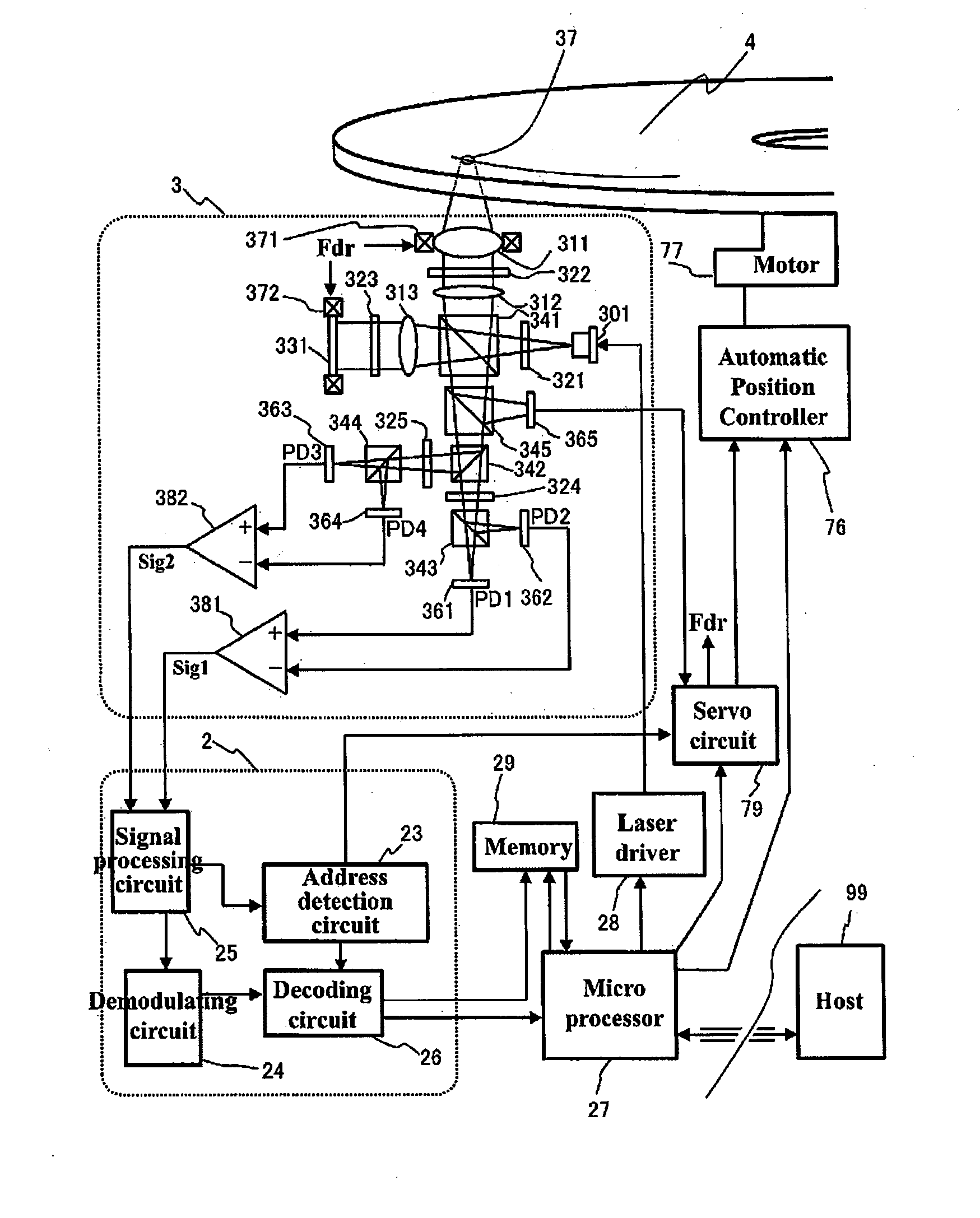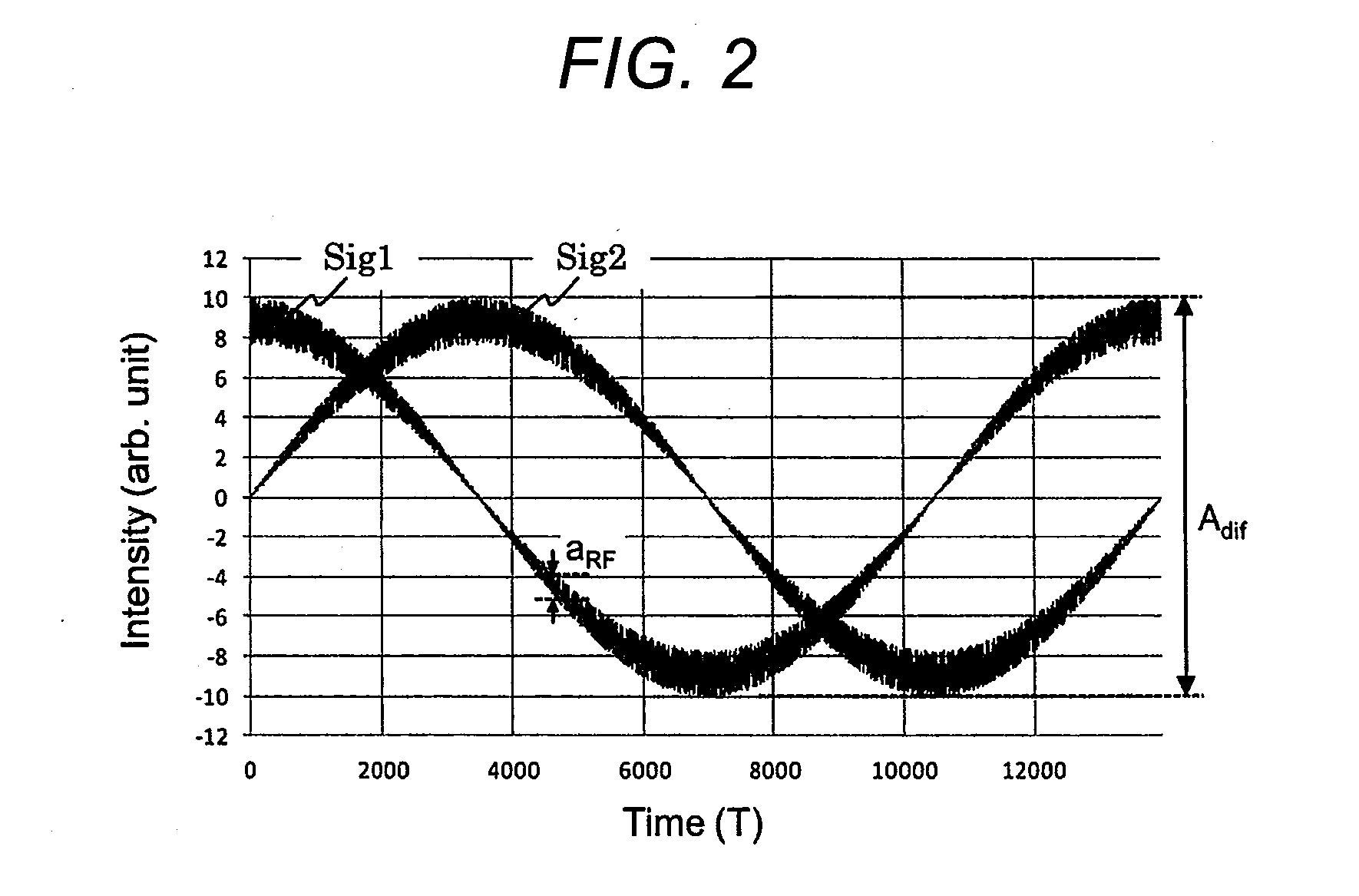Optical information reproduction apparatus
- Summary
- Abstract
- Description
- Claims
- Application Information
AI Technical Summary
Benefits of technology
Problems solved by technology
Method used
Image
Examples
embodiment 1
[0065]FIG. 4 shows a block diagram of an optical disc apparatus as an embodiment of the invention. The light emitted from a blue laser diode 301 with a wavelength of 405 nm mounted on an optical head 3 is transmitted through a first half wave plate 321 to thereby have the polarization direction rotated 45 degrees. The light with the polarization direction rotated is split by a first polarization beam splitter 341 into two linearly-polarized lights perpendicular to each other. The light (reproduction light) with one of the polarized lights is reflected, and is then collimated by a first collimator lens 312 into a parallel light, then transmitted through a first quarter plate 322 to thereby be converted into circularly-polarized light, then collected by an objective lens 311 with an NA of 0.85, and then an optical disc 4 is irradiated with the light. The reflected light (hereinafter referred to as a signal light) from the optical disc 4 is restored again to the parallel light by the o...
embodiment 2
[0071]FIG. 6 is a flowchart showing a procedure of determining the vertical resolution of the A / D converters 505 and 506 in EMBODIMENT 1 described above. As an overall flow, the vertical resolution RRF0 necessary and sufficient for the case of the normal detection is obtained in the steps S601 through S603, the increment ΔR of the vertical resolution is determined in the step S604, and the vertical resolution R in the case of the Homodyne phase diversity detection is determined in the step S605 based on RRF0 and ΔR.
Step S601:
[0072]FIG. 12 is a diagram showing a signal processing circuit used for obtaining the necessary and sufficient vertical resolution in the case of the normal detection. The reference symbol Sig0 denotes the reproduced signal obtained using a normal detector, which does not use the Homodyne phase diversity detection. The reproduced signal Sig0 is obtained by, for example, using a disc medium of a type with a single recording layer so that the sufficient S / N ratio ...
embodiment 3
[0081]FIG. 7 is a diagram showing a configuration of a signal processing circuit added with gain / offset adjustor circuits for applying the gain / offset to the two differential signals in the anterior stage of the A / D converters, respectively, as another embodiment of the signal processing circuit block.
[0082]As is pointed out in Document 1 or Document 2, in the case in which imbalance in amplitude between the two differential signals exists, and in the case in which an offset exists in each of the differential signals, the stable reproduced signal independent of the phase difference between the signal light and the reference light fails to be obtained even if the calculation expressed by the formula (7) is performed. According to the present embodiment, by performing an adjustment so that the amplitudes of the two differential signals become equal to each other, and the offset of each of the two differential signals vanishes using the signal adjustors 501, 502 added in the anterior s...
PUM
 Login to View More
Login to View More Abstract
Description
Claims
Application Information
 Login to View More
Login to View More - R&D
- Intellectual Property
- Life Sciences
- Materials
- Tech Scout
- Unparalleled Data Quality
- Higher Quality Content
- 60% Fewer Hallucinations
Browse by: Latest US Patents, China's latest patents, Technical Efficacy Thesaurus, Application Domain, Technology Topic, Popular Technical Reports.
© 2025 PatSnap. All rights reserved.Legal|Privacy policy|Modern Slavery Act Transparency Statement|Sitemap|About US| Contact US: help@patsnap.com



